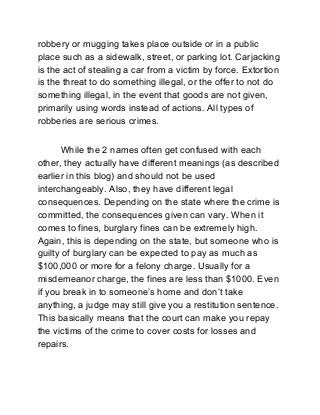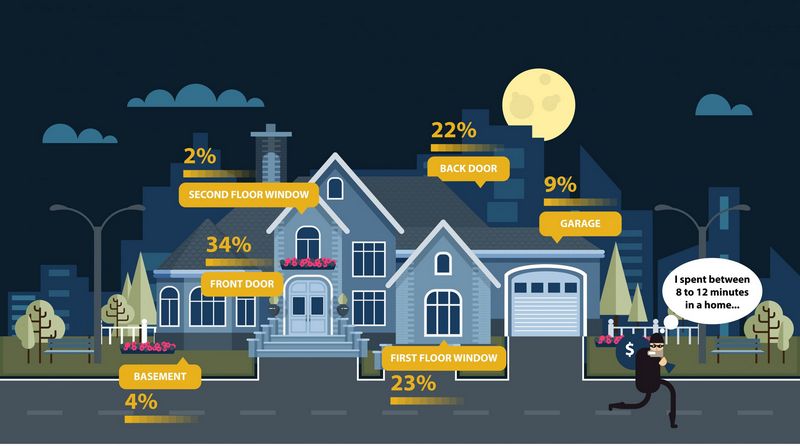
Understanding The Difference Between Robbery And Burglary
In our society, crimes are unfortunately a reality that we must contend with. Two common crimes that often make headlines are robbery and burglary. While these terms are sometimes used interchangeably, it is essential to understand that they are distinct offenses with different characteristics and legal implications.
Robbery refers to the act of taking someone else’s property by using force, threats, or intimidation. It involves direct confrontation and often occurs in public spaces where victims are present. Robbery is a violent crime that puts the victim at risk of physical harm or injury. The motive behind robbery is usually to obtain immediate possession or control of the targeted item, such as money or valuable belongings.
Burglary, on the other hand, involves the unlawful entry into a building or dwelling with the intent to commit a crime inside, usually theft. Unlike robbery, burglary typically occurs when the premises are unoccupied, such as when homeowners are away or businesses are closed. It is a stealth crime where the intruder aims to avoid detection and works silently to accomplish their unlawful objectives. Burglary centers around unlawfully entering a structure with the intent to commit a crime inside, usually theft.
While both robbery and burglary involve unlawful taking of property, the key distinction lies in the presence or absence of confrontation and the location of the crime. Robbery involves direct confrontation and often occurs in public spaces, while burglary is a stealth crime that takes place in unoccupied buildings or dwellings. Understanding the differences between these two crimes is crucial for the legal system, law enforcement, and the general public in terms of appropriate charges, investigations, and prevention strategies.
Understanding The Difference Between Robbery And Burglary
The terms “robbery” and “burglary” are often used interchangeably, but it is important to understand the difference between them. Both crimes involve unauthorized entry into a property, but there are key distinctions that separate the two.
Robbery:
Robbery is a crime that involves taking someone’s property by force or the threat of force. It typically occurs when a person confronts the victim directly and demands their belongings. Robberies often occur in public places or even in someone’s home, where the suspect uses intimidation or violence to make the victim comply. This crime is seen as a more violent offense and can carry severe penalties, including imprisonment.
Burglary:
Burglary, on the other hand, is the act of breaking into a building or structure with the intent to commit a crime. It involves the unauthorized entry into a property, usually when no one is present. The intention may be to steal property, commit an assault, or even vandalize the premises. Unlike robbery, burglary does not involve direct confrontation with the victim. Instead, it focuses on unlawful entry and the intent to commit a crime.
Differences:
| Involves the use of force or threat of force | Does not require direct confrontation |
| Often occurs in public places or the victim’s home | Usually happens when no one is present |
| Can lead to immediate harm to the victim | Focuses on unlawful entry and intent to commit a crime |
Understanding the difference between robbery and burglary is crucial for law enforcement, the general public, and the legal system. Each crime carries its own set of consequences and requires a different approach for prevention and investigation.
The Legal Definitions
Understanding the legal definitions of burglary and robbery is important in order to differentiate between these two crimes. While both involve the unlawful taking of someone else’s property, there are key differences in how they are defined and prosecuted.
Burglary refers to the act of entering a building or structure with the intent to commit a crime inside. This crime typically involves unlawfully entering a person’s home or business, and the intent to commit theft, assault, or other felonies. It is important to note that the act of burglary only requires the unlawful entry, regardless of whether any theft or other crimes are successfully carried out.
On the other hand, robbery refers to the act of taking someone else’s property by force or threat of force. This crime typically involves the use or threat of violence or intimidation to take another person’s belongings. Unlike burglary, robbery does not require unauthorized entry into a building or structure. It focuses more on the act of physically taking someone else’s property forcefully.
The legal definitions of burglary and robbery may vary slightly depending on the jurisdiction, but the key elements of unlawful entry and forceful taking are generally consistent. Understanding the differences between these crimes can help individuals and law enforcement officials accurately identify and address the relevant legal issues.
Types of Crimes
Understanding the difference between burglary and robbery is important when it comes to different types of crimes. Both burglary and robbery are criminal acts, but they involve different actions and circumstances.
- Burglary: This is a crime where a person enters a building or structure without permission and with the intent to commit a crime. It typically involves theft or vandalism. Burglaries usually occur when the building or structure is unoccupied.
- Robbery: This is a crime where a person uses force or intimidation to take property directly from another person. It often involves violence or the threat of violence. Robberies can occur in various locations, such as on the street, in a store, or in someone’s home.
While both burglary and robbery involve theft, the key difference is that burglary involves unlawful entry into a building or structure, whereas robbery involves the use of force or intimidation against a person. Understanding the distinction between these crimes is essential for legal purposes and for ensuring the safety and security of individuals and property.
Elements of Robbery
Robbery is a serious crime that involves taking someone else’s property by force or threat of force. It is important to understand the key elements of robbery, which differentiate it from other crimes such as burglary.
1. Force or Threat of Force: Unlike burglary, robbery involves the use of force or threat of force to take someone else’s property. This force can be physical, such as pushing or hitting the victim, or it can be verbal, such as threatening to harm the victim if they do not comply.
2. Taking of Property: The act of robbery also requires the actual taking of property from the victim. The property can be physical objects, such as money, jewelry, or electronics, or it can be intangible, such as credit card information or personal identification.
3. Victim Present: Another key element of robbery is that the victim must be present during the commission of the crime. Unlike burglary, which typically occurs when the victim is not home, robbery involves direct confrontation with the victim.
4. Intent: The intent to commit a robbery is also an essential element. The perpetrator must have the specific intention to use force or threat of force to take someone else’s property. Without this intent, the crime would not be considered a robbery.
In summary, robbery is a crime that differs from burglary in several key elements. It involves the use of force or threat of force, the taking of property, the presence of the victim, and the intent to commit the crime. Understanding these elements is crucial for distinguishing between robbery and other similar crimes.
Elements of Burglary
Burglary is a crime that involves unlawful entry into a building with the intent to commit a felony or theft. To understand the difference between burglary and robbery, it is essential to examine the elements of burglary:
1. Unlawful Entry: The first element of burglary is the unlawful entry into a building. This means that the person enters the premises without permission or authorization from the owner or occupant.
2. Building: Burglary involves the unlawful entry into a building. A building can vary from residential houses and commercial establishments to storage units and vehicles. However, it does not include open land or structures without a roof.
3. Intent: The intent to commit a felony or theft is a crucial element of burglary. The offender must have the intention to engage in criminal activity once inside the building. It is not necessary for the intent to be successful; the mere intention is enough to satisfy this element.
4. Felony or Theft: The final element of burglary is the intent to commit a felony or theft. Felonies include crimes such as robbery, assault, or murder, while theft involves the unlawful taking of another person’s property without their consent.
Understanding the elements of burglary helps differentiate it from robbery, which involves the use of force or threat to take someone’s property directly from their person. While both crimes involve unlawful entry, burglary focuses on the unlawful entry into a building with the intent to commit a felony or theft.
Use of Force
Understanding the difference between robbery and burglary also involves understanding the use of force. While both crimes involve illegal entry into another person’s property with the intent to steal, robbery includes the use of force or threat of force against the victim.
In a robbery, the perpetrator confronts the victim directly, whether through physical violence or the threat of it. This use of force differentiates robbery from burglary. In a burglary, the perpetrator typically enters the premises without the knowledge or presence of the occupant. They aim to steal valuables without encountering any resistance.
The use of force in a robbery makes it a particularly dangerous crime. It poses a significant threat to the victim’s safety and well-being. The victim may be physically harmed, or even killed, if they resist the perpetrator or fail to comply with their demands.
Law enforcement agencies take robbery very seriously due to the potential for violence involved. The use of force escalates the severity of the crime and can result in harsher penalties for the offender. Understanding this distinction is crucial for individuals seeking to protect themselves and their property.
Presence of Victim
In terms of the presence of a victim, there is a notable difference between robbery and burglary. In a robbery, the perpetrator confronts the victim directly and uses force, threat, or intimidation to take their belongings or property. The victim is typically present during a robbery and may be subjected to physical harm or emotional distress. The intention of the robber is to obtain immediate control over the victim and their possessions.
On the other hand, burglary involves the unlawful entry into a building or structure with the intent to commit a crime inside. Unlike robbery, a burglary may or may not involve the presence of a victim at the time of the crime. The perpetrator may enter the premises when the occupants are not present or when they are asleep, unaware of the intrusion. The primary goal of a burglar is to unlawfully obtain valuable items or commit other offenses without directly confronting the inhabitants.
It is important to understand this distinction between robbery and burglary, as they involve different criminal acts and have different consequences. Both crimes can cause significant harm to the victims, but their nature and approach differ in terms of the presence of a victim.
| Involves direct confrontation with the victim | May or may not involve the presence of a victim |
| Uses force, threat, or intimidation | Involves unlawful entry into a building or structure |
| Immediate control over the victim is the goal | Unlawfully obtaining valuables or committing offenses is the goal |
Location of Crime
Understanding the difference between robbery and burglary also involves considering the location of the crime. In both cases, the crime takes place on someone else’s property without their consent. However, the key difference lies in the presence of a victim.
During a robbery, the crime occurs in the presence of the victim. This means that the offender directly confronts the victim, using intimidation or force to steal their belongings. Robberies often take place in public areas, such as streets, parks or stores. The victim may be threatened with a weapon or physically harmed during the robbery.
On the other hand, a burglary takes place when the property owner is not present. The offender enters the premises without permission to commit theft or any other crime. Burglaries typically occur in private residences, businesses, or other locations where valuables are kept. The intent is to enter the premises secretly and without the knowledge of the owner.

Understanding the location of the crime is crucial in differentiating between robbery and burglary. The presence or absence of a victim during the commission of the crime is a key factor in determining the type of offense and the potential charges that may be brought against the offender.
Motive
Understanding the difference between burglary and robbery requires examining the motive behind each crime. While both crimes involve the unlawful taking of someone else’s property, their motives differ significantly.
Burglary is typically carried out with the motive of obtaining valuable belongings without encountering the property owner or occupant. The burglars often choose to target homes or buildings when they believe the occupants are not present. The objective of burglary is to stealthily enter a property, steal valuable items, and exit without detection. The motive behind burglary is usually financial gain, as the stolen items can be sold or used to obtain money.
On the other hand, the motive behind robbery is usually to forcibly take someone else’s property or belongings while directly confronting the victim. Robbers are more likely to target individuals or businesses in public places, such as banks, convenience stores, or even pedestrians on the street. Unlike burglary, robbery involves face-to-face confrontation, intimidation, or violence to achieve the goal of obtaining the victim’s property. Robbery motives can range from obtaining money to satisfy drug addiction, settling personal scores, or simply preying on vulnerable individuals.
Therefore, the main difference between burglary and robbery lies in their motives. While burglary aims to steal without direct confrontation, robbery involves direct confrontation and intimidation in order to obtain the victim’s property.
Punishment
Understanding the difference between burglary and robbery is crucial, as the penalties for these crimes are significantly different. The punishments handed down by the courts are intended to reflect the seriousness of the offense and act as a deterrent for potential offenders.
For burglaries, the punishment typically includes imprisonment, fines, or a combination of both. The severity of the punishment is often determined by factors such as the value of the stolen goods, whether the offender has any prior criminal record, and whether any violence or harm was caused during the crime.
In the case of robbery, the penalties are generally more severe. This is because robbery involves directly taking property from a person using force or threats of violence. The punishment for robbery can include longer prison sentences, higher fines, and even restitution to compensate the victim for any losses or injuries sustained.
It is important to note that laws regarding burglary and robbery vary between jurisdictions, so the specific punishments for these crimes can differ. However, regardless of the jurisdiction, both burglary and robbery are considered serious criminal offenses and can result in significant penalties.
By understanding the difference between burglary and robbery, individuals can better comprehend the potential consequences they may face if they engage in such criminal activities. This knowledge can serve as a deterrent and encourage individuals to make more responsible choices, ultimately contributing to a safer society.
Legal Proceedings
Understanding the difference between robbery and burglary is crucial in legal proceedings. Both robbery and burglary are criminal offenses, but they differ in several aspects.
Robbery involves the act of taking someone’s property through the use of force, threat, or intimidation. It is a crime against a person and often involves direct confrontation. In legal proceedings, a robbery case requires proof of the offender’s intent to commit theft and the use of force or fear to take the victim’s property. The severity of a robbery offense may vary depending on factors such as the presence of a weapon or the degree of violence used.
On the other hand, burglary refers to the act of unlawfully entering a structure with the intent to commit theft or other felonious acts. Unlike robbery, burglary is a crime against property rather than a person. In legal proceedings, prosecuting a burglary case involves providing evidence that the accused unlawfully entered a building or dwelling and had the intention to commit a crime inside. The actual theft does not need to occur for a burglary charge to be applicable.
During legal proceedings related to robbery or burglary cases, the court examines the evidence presented to determine the guilt or innocence of the accused. The burden of proof lies with the prosecution, who must establish the intent and actions of the defendant beyond a reasonable doubt. The defendant has the right to present a defense and challenge the evidence against them.
The legal ramifications of a robbery or burglary conviction can vary depending on the jurisdiction and the specific circumstances of the case. Penalties can include imprisonment, fines, restitution to victims, and probation or parole. Repeat offenses or cases involving aggravating factors may result in more severe punishments.
Understanding the legal proceedings surrounding robbery and burglary is essential for those involved in criminal law, including law enforcement officers, attorneys, judges, and jurors. By distinguishing the differences between these two offenses, the justice system can ensure fair and accurate determinations of guilt or innocence.
Reporting a Crime
Understanding the difference between robbery and burglary is important when reporting a crime. Both crimes involve the unlawful act of taking someone’s property, but there are key distinctions between them.
Robbery is a crime that involves the use of force or threat of force to take someone’s property directly from their person or immediate presence. For example, if someone threatens you with a weapon and takes your wallet, that would be considered a robbery.
Burglary, on the other hand, is the unlawful entry into a building or dwelling with the intent to commit a theft or another felony inside. Unlike robbery, burglary does not require the presence of the victim during the commission of the crime. For instance, if someone breaks into your house while you are away and steals your valuables, that would be considered a burglary.
When reporting a crime to the authorities, it is important to provide as much detail as possible, including the location, time, description of the perpetrator, and any other relevant information. This information can help the police in their investigation and increase the chances of apprehending the culprit.
If you are a victim of either robbery or burglary, it is important to report the crime promptly. Contact your local police department or emergency hotline to report the incident and provide them with all the necessary information. Remember, reporting a crime is crucial for the safety of yourself and your community.
| Uses force or threat | Unlawful entry into a building |
| Takes property directly from person | Intent to commit theft or felony inside |
| Presence of victim | No requirement of victim’s presence |
Prevention Tips
Understanding the difference between robbery and burglary is important for taking effective prevention measures. Here are some tips to help protect yourself and your property:
1. Keep your doors and windows locked at all times, even when you’re at home. This will deter potential burglars from trying to enter your property.
2. Install a security system, including surveillance cameras and alarms. These can help deter criminals and provide evidence in case of a break-in.
3. Be vigilant of your surroundings and report any suspicious activities to the authorities. This can help prevent robberies and burglaries in your neighborhood.
4. Don’t advertise your valuables. Keep curtains or blinds closed to prevent outsiders from seeing what you have inside your home.
5. Keep your property well-lit, both inside and outside. Adequate lighting can deter criminals and make it easier for witnesses to identify them.
6. Store valuable items in a safe or hidden place. This can include important documents, jewelry, and electronics.
7. Get to know your neighbors and establish a neighborhood watch program. This can create a sense of community and discourage criminals from targeting your area.
8. When leaving your home for an extended period, let trusted neighbors or family members know. They can keep an eye on your property and report any suspicious activities.
By following these prevention tips, you can reduce the risk of becoming a victim of robbery or burglary.
Statistics and Trends
Understanding the statistics and trends surrounding robbery and burglary can help individuals and communities take necessary precautions to protect themselves and their property.
Robbery is a violent crime that involves the use of force or threat of force to steal personal property from an individual. According to recent studies, the number of reported robbery cases has been decreasing over the past few years, which is encouraging.
Burglary, on the other hand, is a property crime that involves illegally entering a building or structure with the intention to commit theft. Statistically, burglary rates have also been declining, although at a slightly slower rate compared to robbery.
It is important to note that both robbery and burglary can leave victims feeling violated and fearful. Understanding the patterns and trends can help law enforcement agencies allocate resources and develop strategies to prevent and apprehend offenders.
Furthermore, technology has played a significant role in deterring and solving these crimes. The use of security systems, surveillance cameras, and community watch programs has proven to be effective in reducing the occurrence of both robbery and burglary.
Additionally, public awareness campaigns and educational programs aimed at teaching individuals about home security measures and personal safety have contributed to the decline in these crimes.
Despite the positive trends, it is still important for individuals to remain vigilant and take proactive steps to protect themselves and their property. Locking doors and windows, investing in good quality locks, and reporting suspicious activities to law enforcement are simple yet effective ways to prevent becoming a victim of robbery or burglary.
In conclusion, understanding the statistics and trends surrounding robbery and burglary is crucial for individuals and communities. By remaining informed and taking necessary precautions, we can work towards creating safer environments for everyone.
Robbery vs Burglary in the Media
Understanding the difference between burglary and robbery is important when it comes to reporting and consuming news in the media. These terms are often used interchangeably, but they have distinct meanings and implications.
Burglary refers to the illegal act of breaking into a building or structure with the intention of committing a crime, usually theft. It typically occurs when the occupants are not present, such as when a house or business is unoccupied. Burglaries are characterized by the unlawful entry and the intent to steal or commit a felony.
On the other hand, robbery involves the act of unlawfully taking someone’s property through the use of force or fear. It is committed against a person or in their presence, making it a more direct and personal crime. Unlike burglary, robbery involves confrontation and the threat or use of violence, which adds an extra layer of danger and trauma for the victim.
In the media, it is essential to accurately differentiate between robbery and burglary to avoid misrepresentation and to inform the public about the true nature of the crime. Mislabeling a robbery as a burglary or vice versa can lead to misunderstandings and misinterpretations by the audience.
Furthermore, understanding the difference between these two crimes can also help the media in highlighting relevant statistics and trends. By accurately reporting on the number of burglaries and robberies in a given area, the media can provide valuable information to the public and help raise awareness about the safety of their neighborhoods.
Robbery and burglary are both serious crimes that can have significant consequences for everyone involved. The media plays a crucial role in educating the public about these crimes and their implications. By reporting on them accurately and responsibly, the media can contribute to a better understanding of the criminal justice system and the importance of personal safety.
Q&A:
What is the difference between robbery and burglary?
Robbery and burglary are both crimes, but they differ in terms of where they occur and the level of threat or force involved. Robbery typically refers to the act of taking someone’s belongings by force or threat of force, usually in a public place or in the victim’s presence. Burglary, on the other hand, is the act of unlawfully entering a building or structure with the intent to commit a crime, such as theft, inside. It does not require the presence of the victim or the use of force.
Can burglary be considered robbery if the burglar steals from someone while they are present?
No, even if the burglar steals from someone while they are present, it would still be considered burglary rather than robbery. Robbery requires the use of force or threat of force to take someone’s belongings, especially in their presence or in a public place. If the burglar does not use force or threat of force during the act, it would still be classified as burglary, regardless of whether the victim is present or not.
Is robbery a more serious crime than burglary?
In general, robbery is considered a more serious crime than burglary due to its potential for violence and the direct threat it poses to the victim. Robbery involves taking someone’s belongings by force or threat of force, often in a public place or in the presence of the victim. This act of aggression raises the level of danger and can result in physical harm or trauma to the victim. Burglary, on the other hand, typically involves stealing from a building or structure without the use of force or the immediate presence of the victim.
What is the punishment for robbery and burglary?
The punishment for robbery and burglary varies depending on the jurisdiction and the specific circumstances of the crime. In general, robbery is considered a more serious offense and carries harsher penalties, including imprisonment, fines, and probation. The punishment for burglary can also be severe, with potential penalties ranging from fines to imprisonment, depending on the value of the stolen property and the offender’s criminal history.
What are some examples of robbery and burglary?
An example of robbery would be a person using force to steal a purse from someone walking down the street. Another example would be someone robbing a bank while threatening the tellers with a weapon. On the other hand, an example of burglary would be someone breaking into a house while the owners are away and stealing valuable items. Another example would be someone unlawfully entering a store at night and taking money from the cash register. These are just a few examples, and there can be different scenarios and variations of both robbery and burglary.
What is the difference between robbery and burglary?
Robbery and burglary are both crimes against property, but they are different in terms of their nature. Robbery is a crime where a person uses force or threat of force to take someone else’s property, usually in a public place. Burglary, on the other hand, is a crime where a person unlawfully enters a building with the intent to commit a crime inside, such as theft. So, the main difference between the two is that robbery involves a direct confrontation with the victim, while burglary typically takes place when the victim is not present.
Are burglary and robbery considered the same type of crime under the law?
No, burglary and robbery are considered separate crimes under the law because they involve different elements. While both crimes involve taking someone else’s property without permission, there are distinct differences in how they are committed. Robbery involves using force or the threat of force to take someone else’s property, while burglary involves unlawfully entering a building with the intent to commit a crime inside. The penalties for each crime may vary depending on the jurisdiction and the specifics of the case.






